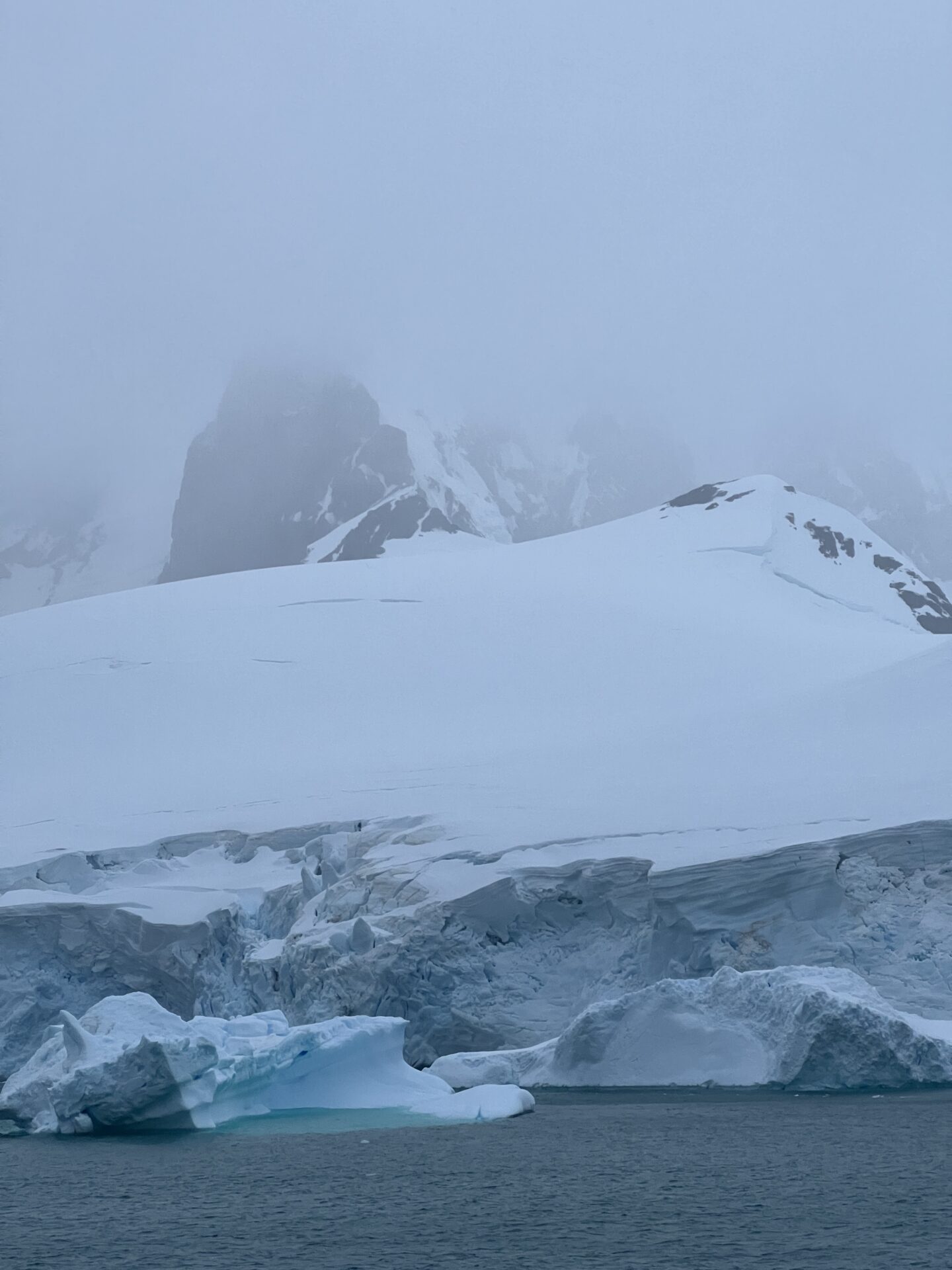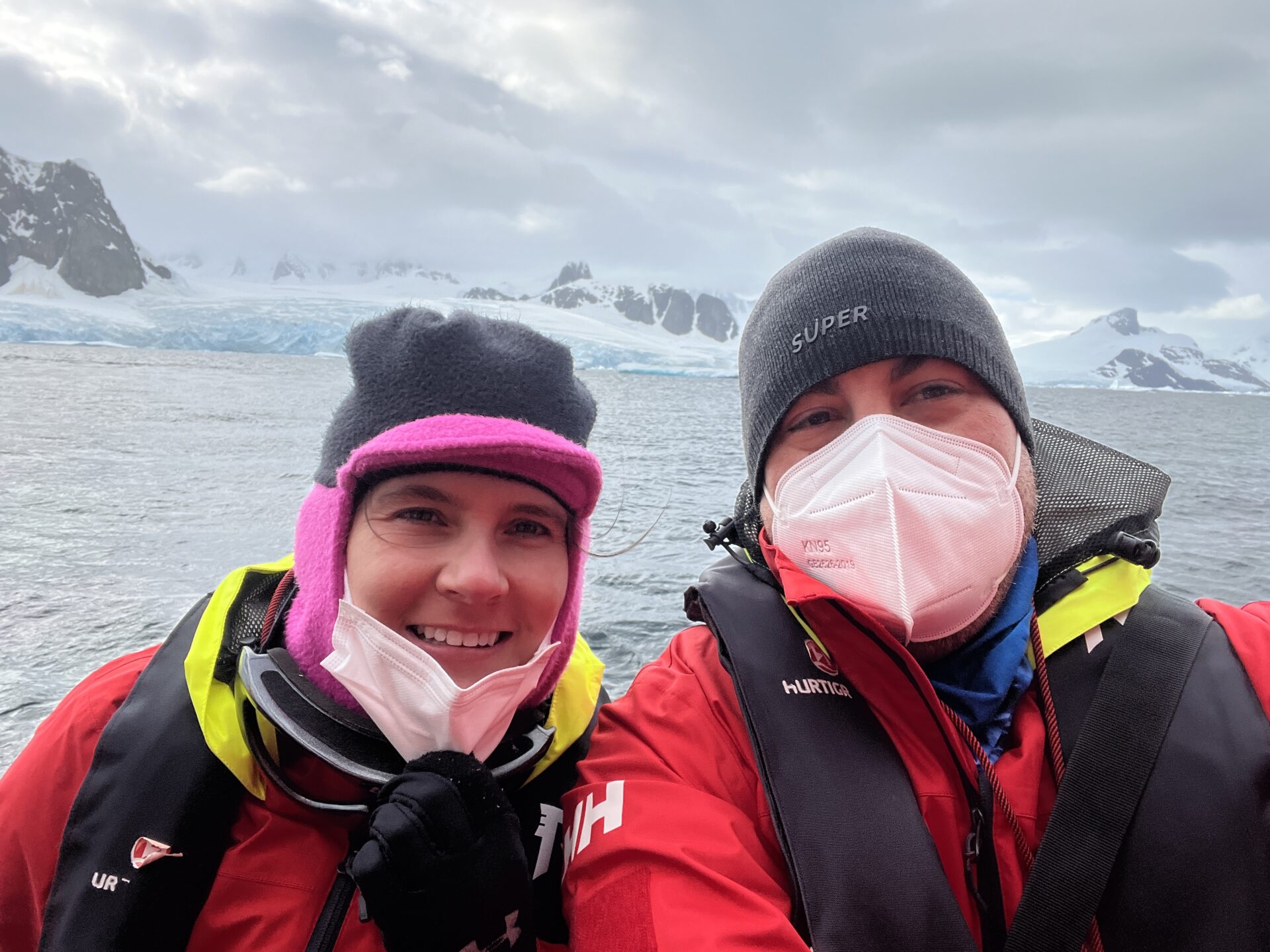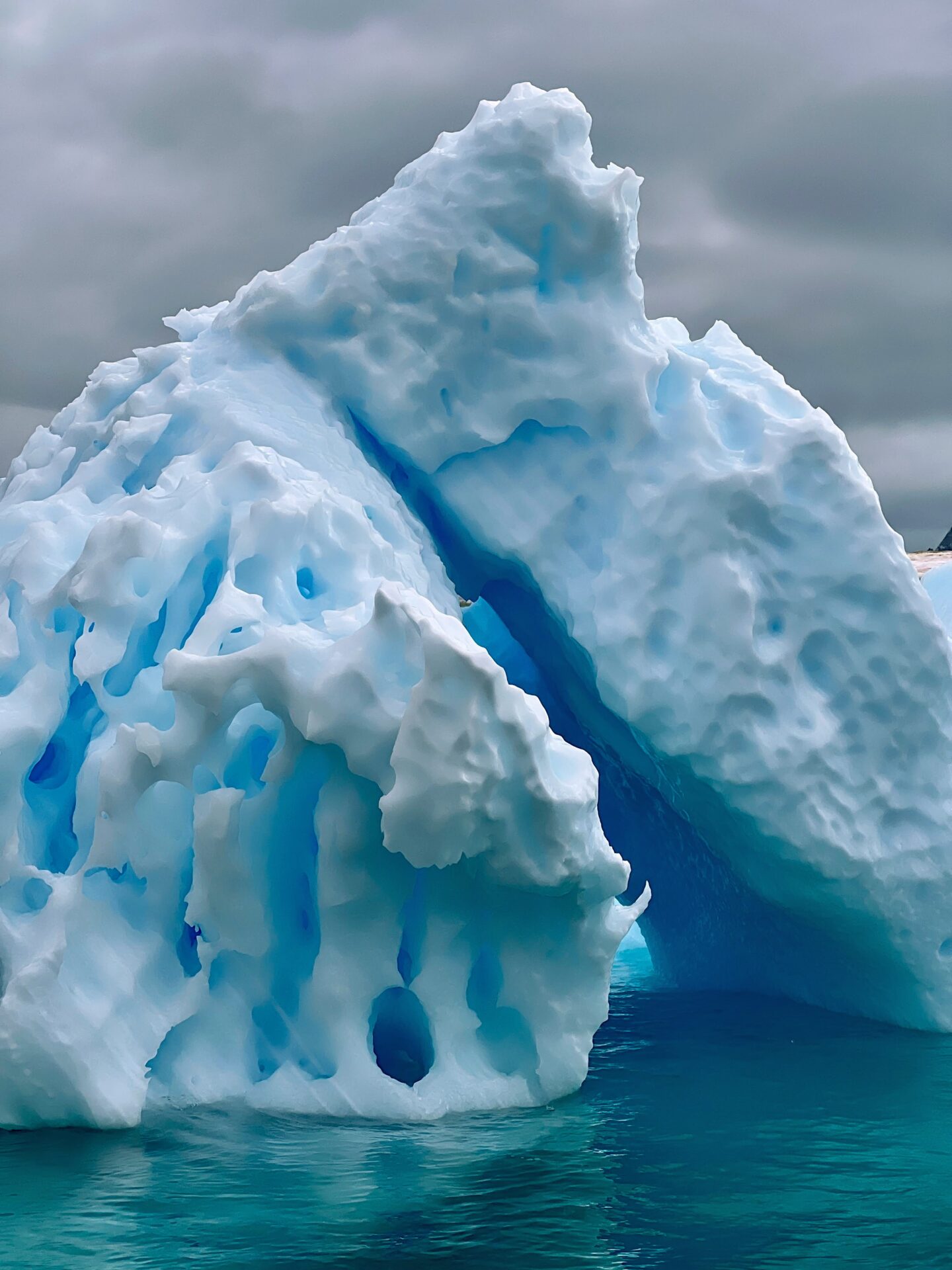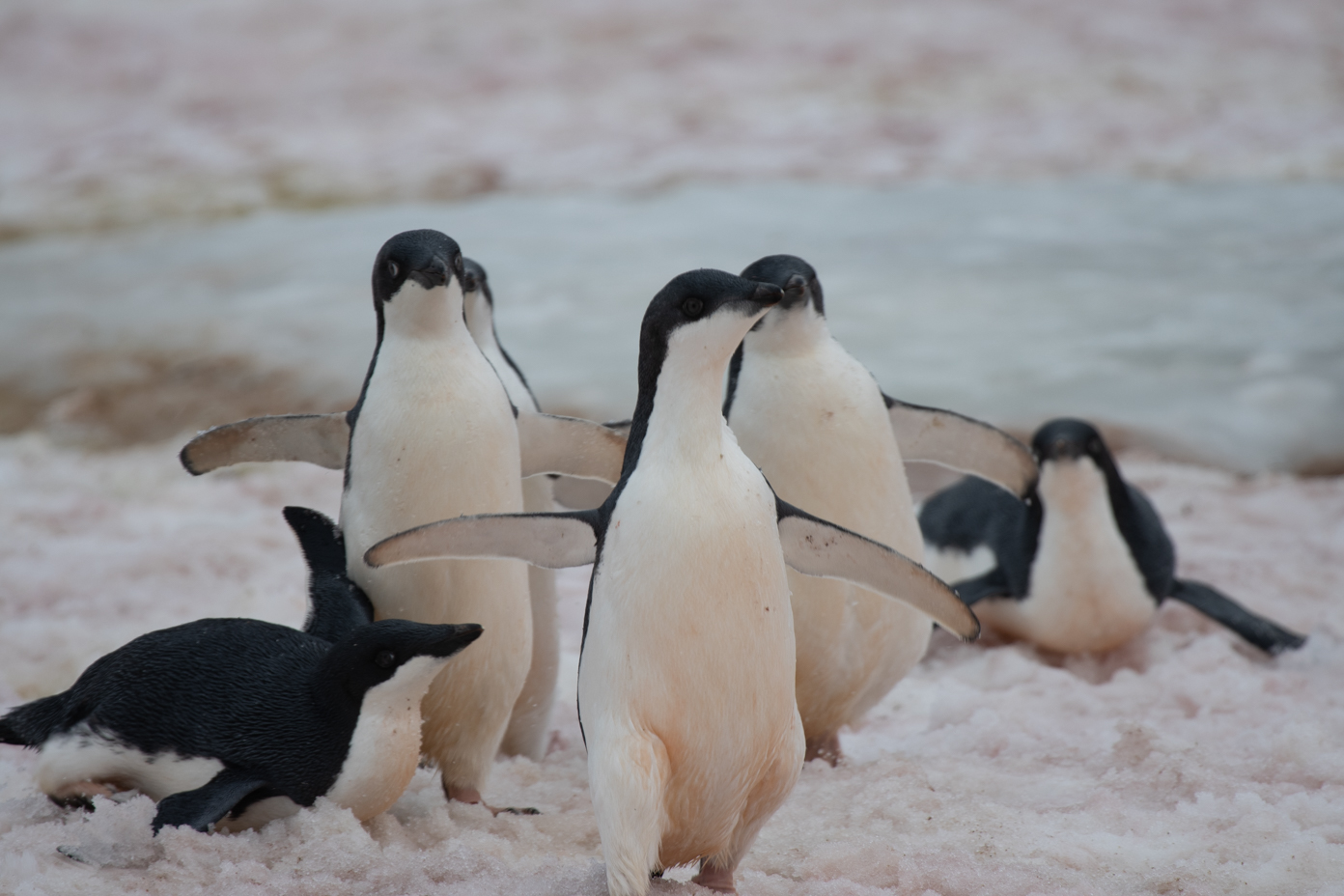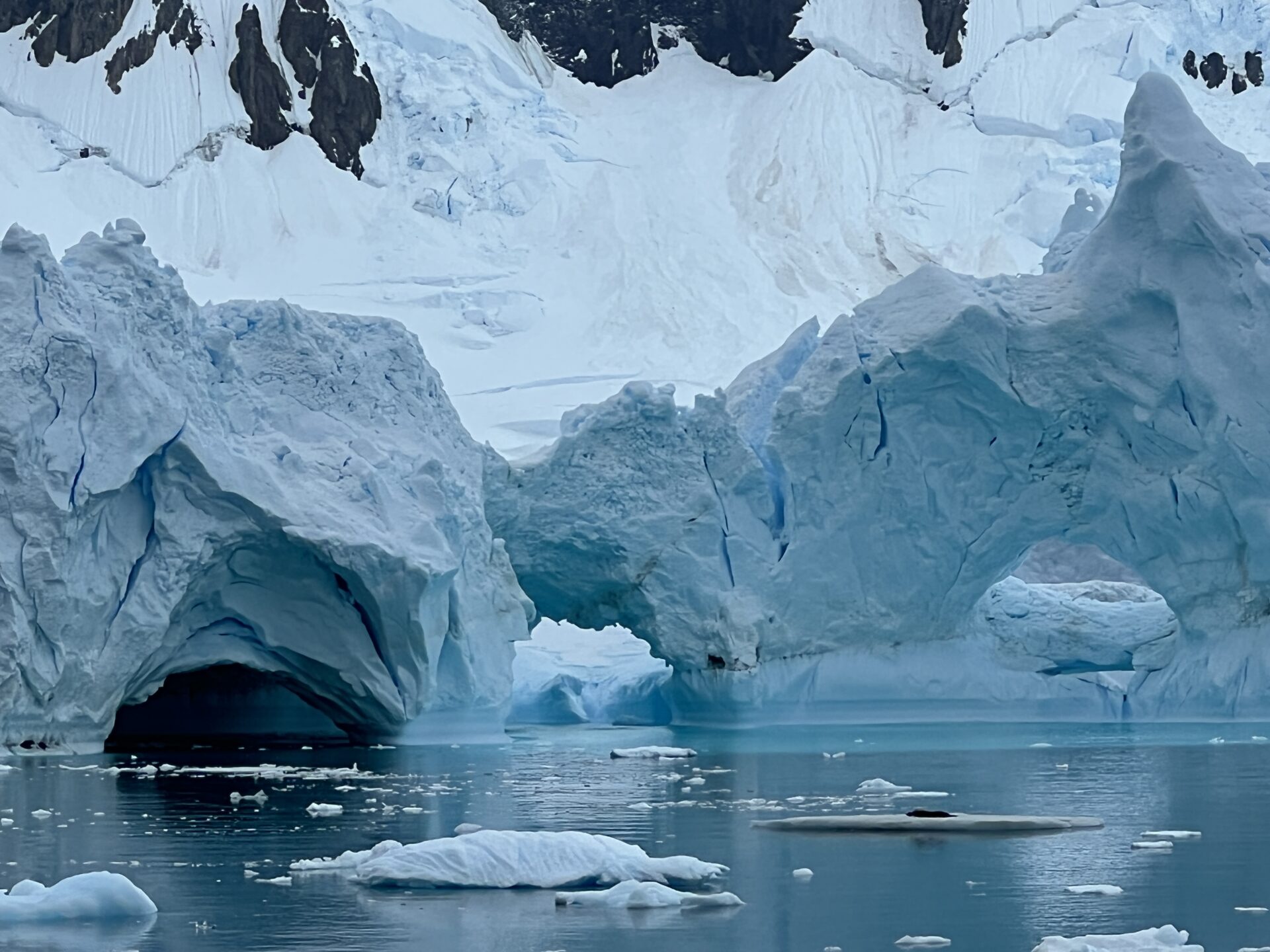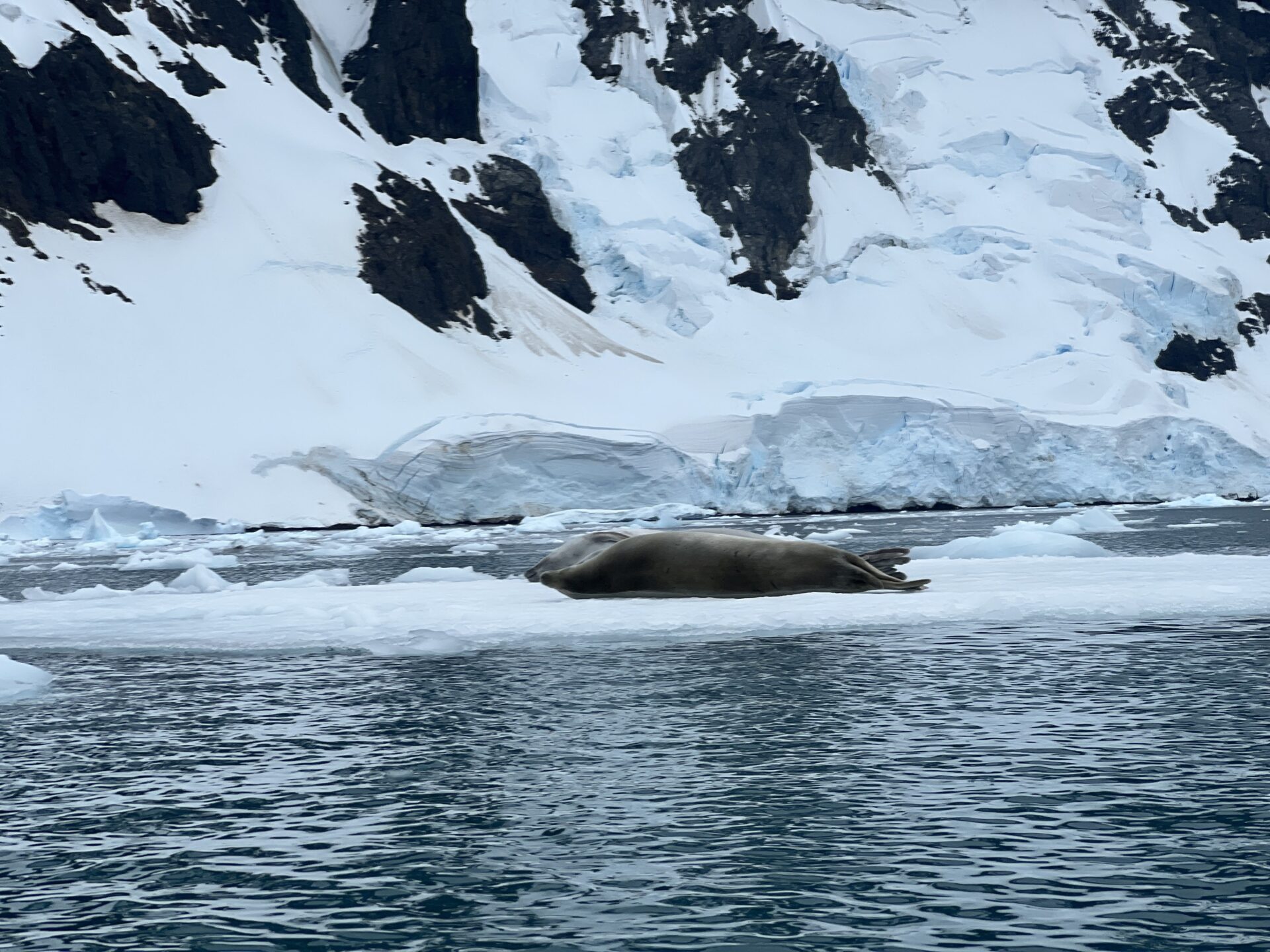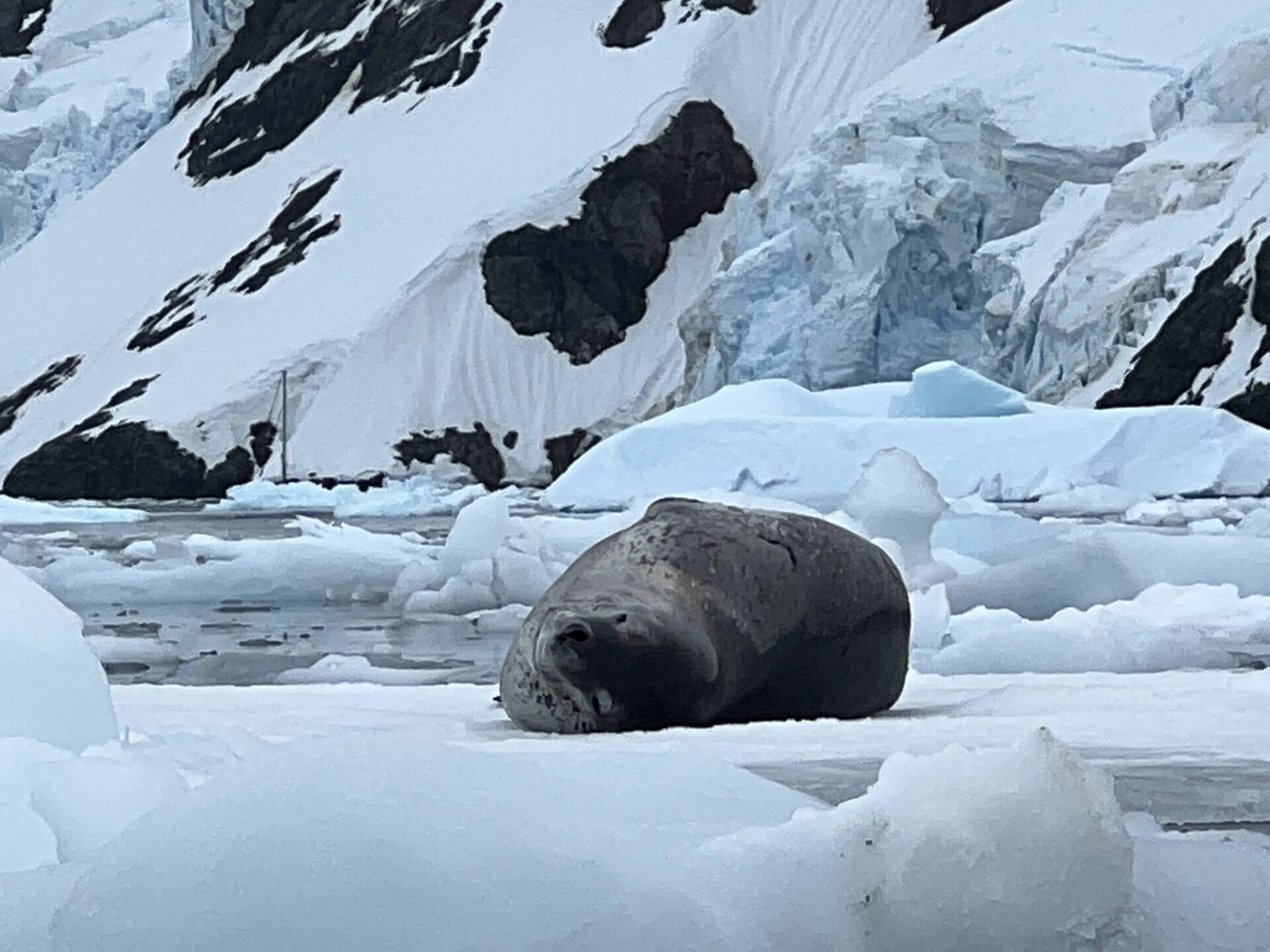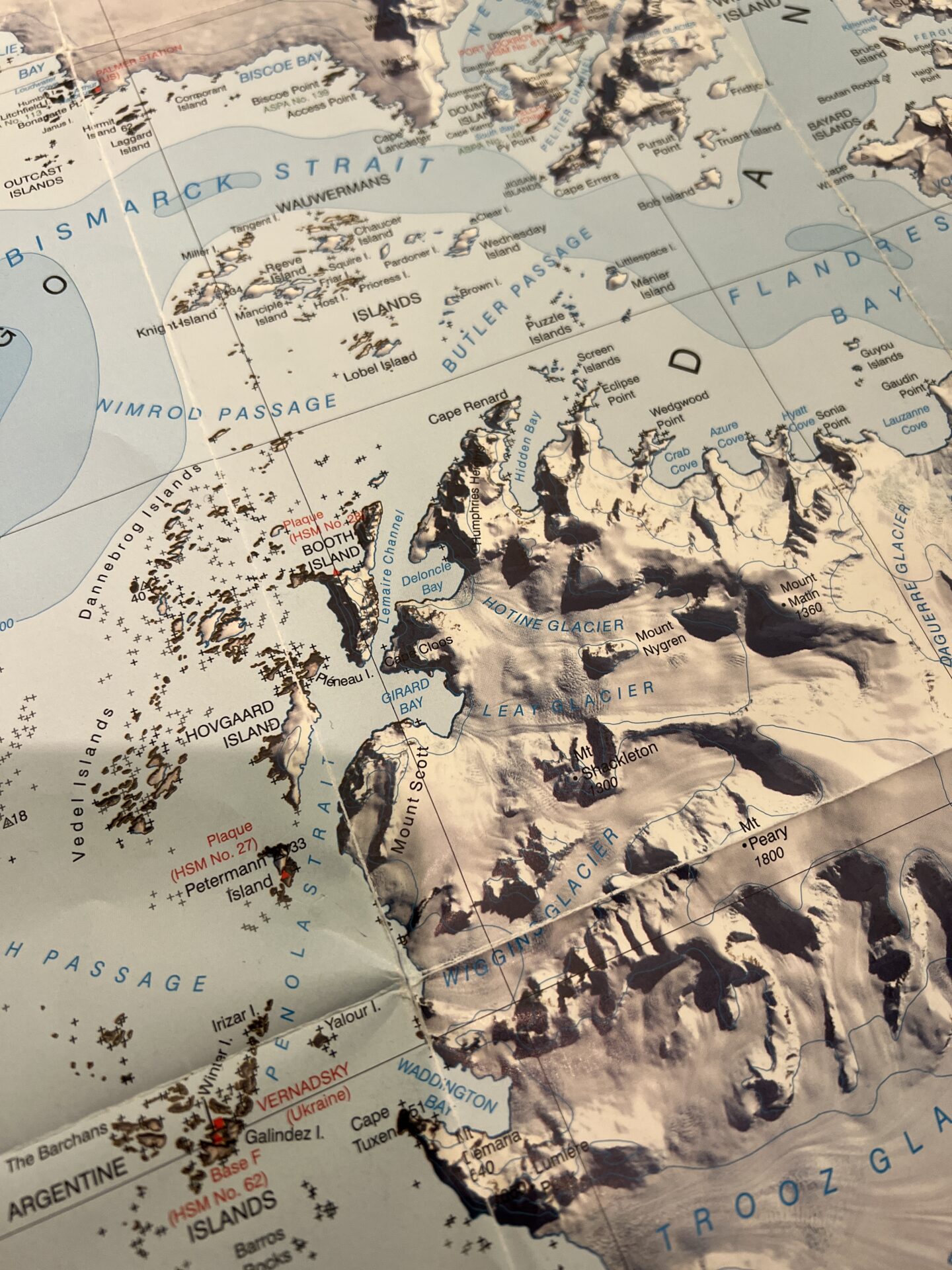We navigated the narrow and treacherous Lemaire Channel in the Antarctic Peninsula, not once but twice – at dusk and in daylight. The Lemaire Channel was our favorite part of our Antarctic expedition, and holds a magical place in our hearts alongside an unforgettable experience.
During dinner we were notified that we would be taking a peak at, and attempting to navigate, the Lemaire Channel around 9PM that night. The Lemaire is an extremely narrow passage that is often filled with icebergs and the voyage prior to ours had not been able to pass through since the ice was too thick. So at the aforementioned time, I went out to see what would happen – CJ came in and out sporadically. It was sleeting a bit, and would pick up a bit more over the next hour. As we headed in, it first appeared that we were heading to a bigger area that we later found was only a bay, but then the ship turned and started heading into a narrow seam.
There were icebergs everywhere, and it was hard to believe we could make it through in any direction. It was amazing to see and feel the way the ship could turn on a dime, and it bobbed and weaved this way and that around the bigger bergs. With the sleet falling and the Antarctic night approaching, a soft diffused light blanketed the landscape with a gray pallor. We creaked through the narrow fjord, hitting smaller bergs and at times medium ones as well with a crash and metal groaning from the hull of the ship. On the sheer cliffs, columns of ice at times crashed into the sea. At times we flowed through pack ice that made a snap, crackle and pop, like Rice Krispies in milk, as we passed. Otherwise everything was hushed as an ethereal mysticism fell over the scene. A night I will remember for the rest of my life.
As I fell asleep that night I wondered how to best describe everything we had seen and would see in Antarctica. An excerpt I had recently read from Kim Stanley Robinson’s book “Antarctica: A Novel” came to mind about how to describe Antarctica:
Still I must try one last time. You see, the air is so clean. Mountains so distant, yet still focused and detailed; as if your eye had become a telescopic. Water lying there glossy and compact, like shot silk in the sun. Never have you seen such clarity before, where the spiritual landscape stuffs the visible landscape until it bursts with luminous presence. Seeing things this clearly makes you wonder what the rest of the world would look like in such clean air. Not that more northerly air could ever be as clean as this, so cold and dry, so dustless–but on certain days, on certain mornings, all the world must once have had this clarity, and we the eyes to see it, and the desire to look. It must have been so beautiful.
It is all so big. Big, huge, vast, stupendous, gigantic–I have said these words many times, I know, and still I must say them over and over, until they react in your heads like paper flowers dropped in water, expanding there to their original size. Really very big! Suggestive of the infinite. Immense simplicity and brio, as in the brush strokes of a bold wise painter. Everything in all five dimensions, all visible at once. This too is so lovely.
The mantle of ice provides such elaboration, on microscales you can barely see in my images, scales of vision you can only experience when you look down at your feet as you walk–visions of the infinitely bedded, planed, crosshatched, and contoured textures of snow and ice, prisming everywhere the colors of the rainbow, spiraling inward all the way to the crystalline patterns in snowflakes, spiraling outward to the massive sculptural bulks of the tabular bergs, each on a masterpiece. Beauty is fractal to infinity in both directions. Clean, big, icy, prismatical–somehow I feel that I’m still not capturing it. Surely these are not the attributes that make this place so ravishing. Perhaps all beauty has a mystery in it that cannot be explained. For this place is beautiful just like this. Seeing the former, we realize the latter. We understand just how beautiful the whole Earth once was. And we can make it that way again.
Kim Stanley Robinson’s book “Antarctica: A Novel”
The next morning, February 9, we awoke early again, and were greeted by Petermann Island where we would be making today’s first landing.
The landing on Petermann was slightly slick rocks, but easy enough to offboard onto. We then walked up the path that our guides had designated with the red flags past an old Argentine station, and to the right towards a Gentoo and Adelie penguin rookery. As we walked we noticed these red spots in the snow, which we later learned was algae that can create both red and green snow. We trekked over and spent a good while watching the various penguins waddle about and go about their business. Often in family groups, but a few creches as well, where both sets of parents were off gathering food and the adolescent chicks were all huddled together for protection.
Though a few skua’s circled looking for a chance to steal one away. After that we walked off to the other side of the island for a great view of icebergs.
Our next landing point was thwarted by heavy winds, so instead we headed back into the mysterious Lemaire Channel. It wasn’t as ethereal during the day, but the lighting did present a great opportunity for better pictures of the sculpted glaciers in the channel, and the plunging cliffs. This is the money shot CJ got and ultimately we blew up and printed on acrylic for hanging above our bed at home.
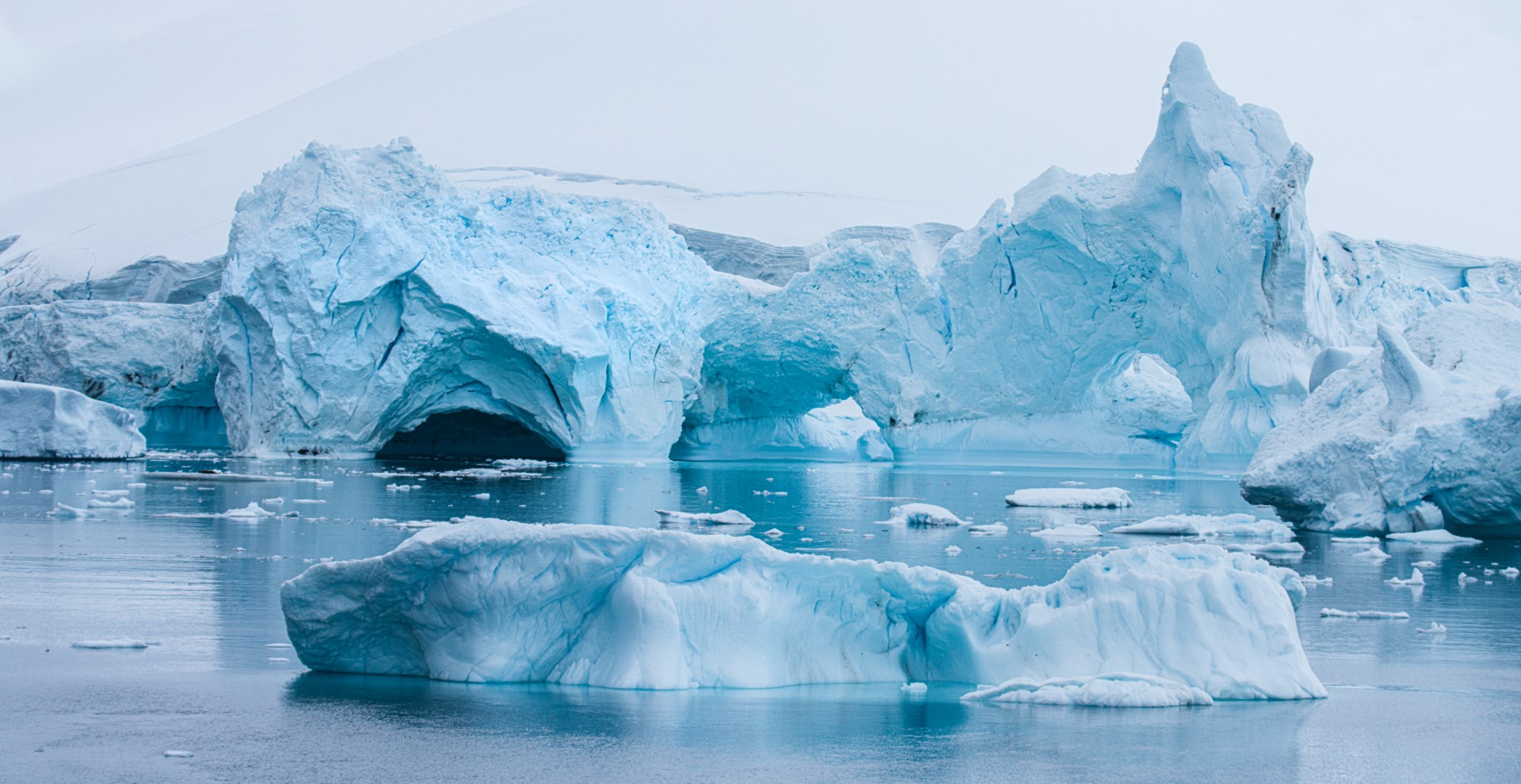
There was also a bit of an Antarctic traffic jam as we headed through, and we had to pause a bit to let another ship, the Aurora, through from the other direction, in addition to two sailboats that joined us in the region a bit later. We wondered how one safely got around in a sailboat down here given all the ice, and even more so about crossing the Drake Passage on such a small vessel. Instead of navigating through the channel, this time we stopped about half way through Lemaire Channel, near Deloncle Bay.
There was no normal landing site here, but the regular groups would be doing zodiac cruising in the spot. However, having been thwarted yesterday for kayaking, that was back on, so we were able to replace one water activity with another. We quickly, or as quickly as one can, donned our dry suits, and went down and wiggled into our tandem kayak. CJ was in front so she could take some better pictures, and I was in the back with control of the rudder. We paddled out and almost immediately came upon four crabeater seals that were lounging on an iceberg. We had seen them previously from the ship, but up close at their level was a whole different and better experience. The water was calm and glassy, and we enjoyed kayaking through the ice and soaking in the scenery. We gave the large icebergs wide berths because they could flip at any moment.
Eventually we came to a leopard seal having a grand ole time lounging on another berg. Leopard seals eat penguins, and outside of the Orca, they are the apex predator of the Antarctic waters. We didn’t want to get too close, but still were probably only about 15 feet away from her (or him), as she wiggled and yawned, giving us great views of her row of serrated teeth. She was large as well, I’d estimate at least 800 to 1,000 lbs, and one of our guides said she was the biggest he’d ever seen. Thankfully she didn’t notice the nearby penguins porpoising, or wasn’t interested in a meal at that time. She looked full and happy.
As we paddled back to the ship, the sound of thunder consistently rang out. We thought perhaps a storm was coming, but it was actually the pressure of the ice shifting and quaking under its own weight. It didn’t always lead to ice cleaving into the water, sometimes it was all happening within the ice. CJ remarked that the sound would make a great “sound machine” to sleep to, less waves crashing and more ice quaking perhaps. We thoroughly enjoyed our time on the water, and getting up close and personal with the water, ice, and wildlife.
It had been one of the best days of our lives, so we went up to the Explorer Lounge to celebrate. CJ with a beer, and me with an Old Fashioned. I even wore my specialty Amundsen brand sweater that I had previously purchased in the gift shop.

Finally, here’s the run down of the day’s fare:
- Breakfast: standard
- Lunch: We both started with mushroom consommé and then moved on to latkes potatoes with beetroot salad.
- Dinner: I started with a mushroom pate, then we both had spicy pumpkin soup with roasted seeds and yogurt (we love us our pumpkin soups and are growing to love them even more over our recent travels), and then on to beef stroganoff, but with mashed potatoes instead of noodles (still scrumptious though!). Then for dessert, CJ had vanilla and brownie ice cream, and I had a blackcurrant mousse and some brownie ice cream on the side.



With our seventh continent now reached, we also added it to our joint history as a couple. You can see where our journey through the Lemaire Channel twice over had taken us so far. And the expedition was only just beginning!




